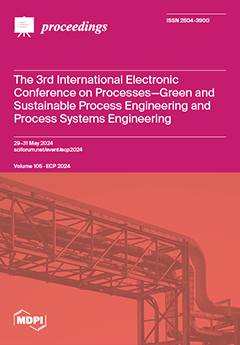Need Help?
Proceedings, 2024, ECP 2024
The 3rd International Electronic Conference on Processes—Green and Sustainable Process Engineering and Process Systems Engineering
Online | 29–31 May 2024
Volume Editor:
Giancarlo Cravotto, University of Turin, Italy
- Issues are regarded as officially published after their release is announced to the table of contents alert mailing list.
- You may sign up for e-mail alerts to receive table of contents of newly released issues.
- PDF is the official format for papers published in both, html and pdf forms. To view the papers in pdf format, click on the "PDF Full-text" link, and use the free Adobe Reader to open them.
Cover Story (view full-size image):
ECP 2024: The 3rd International Electronic Conference on Processes—Green and Sustainable Process Engineering and Process Systems Engineering presents the latest studies in
[...] Read more.
ECP 2024: The 3rd International Electronic Conference on Processes—Green and Sustainable Process Engineering and Process Systems Engineering presents the latest studies in process/system-related research in chemistry, biology, material, energy, environment, food and engineering fields. The conference covers the following topics: green chemistry engineering and environment-relevant processes; experimental, theoretical, and computational research on process development and engineering; process modeling, simulation, optimization, and control; food-relevant processing and improvement of food quality; sustainable and renewable systems engineering; energy system and current demand and electricity market; supply chain management; circular economies; eco-friendly processes and methods.
Previous Issue
Next Issue
Issue View Metrics
Multiple requests from the same IP address are counted as one view.



